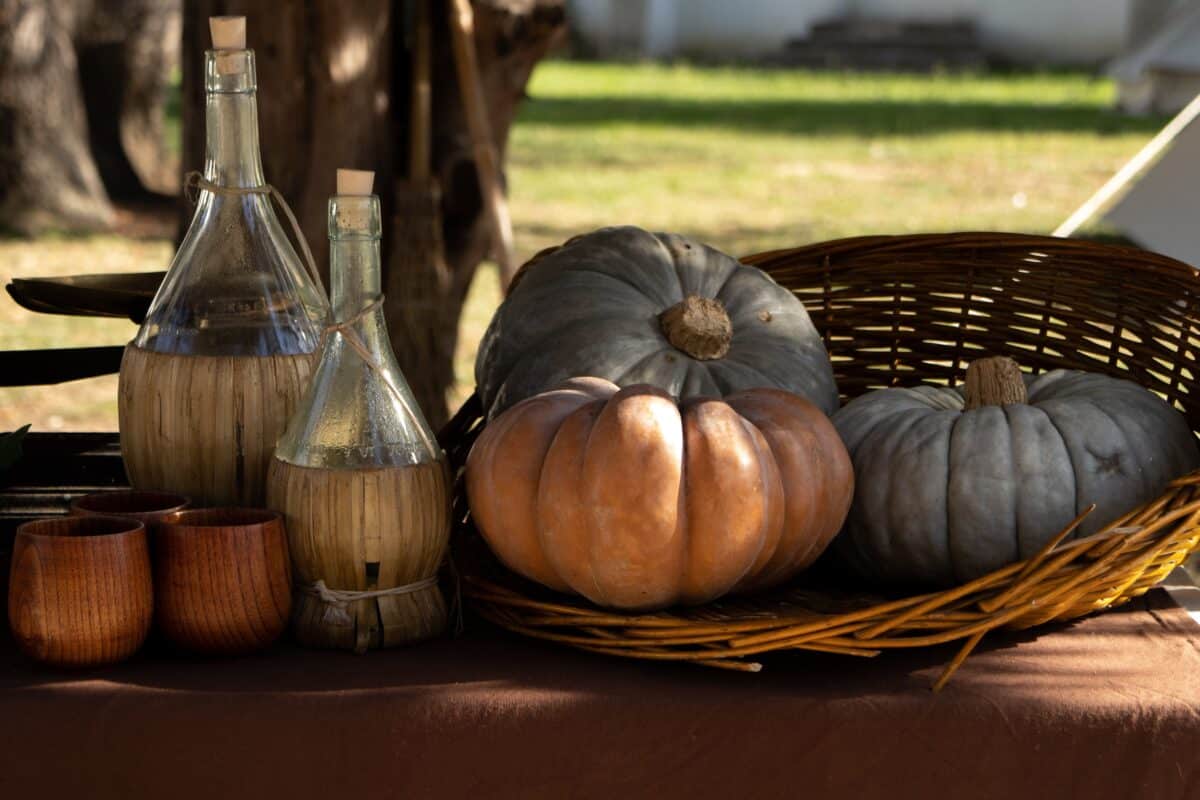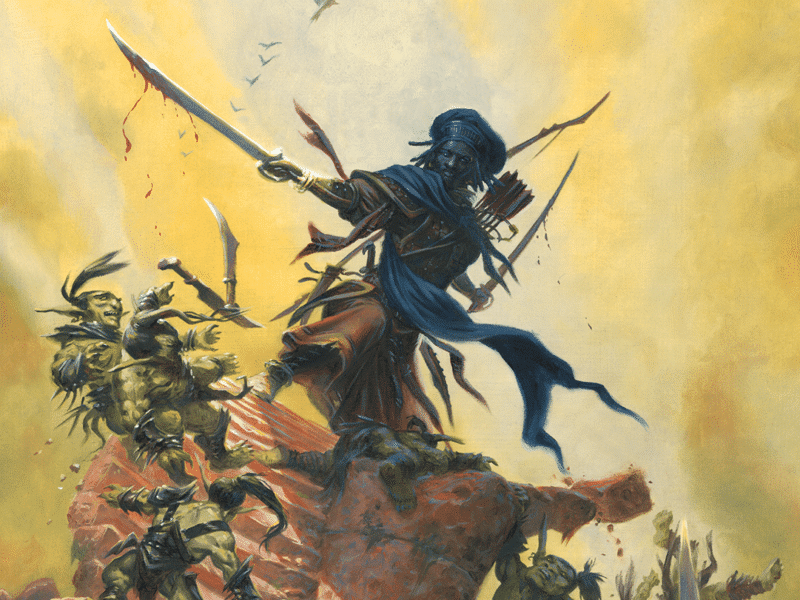Continuing the series on reasons to play different races in Dungeons & Dragons, in this second instalment we’ll turn to a folk that’s as closely related to D&D as elves but at the same time radically different: the halflings.
To understand halflings (and to examine how to have the most fun when playing one), it’s useful to take a look at what inspired their creation. To anyone who’s a fan of fantasy literature as well as roleplaying games, it’s obvious that the halflings are profoundly inspired by the hobbits, a people that play a central role in J.R.R Tolkien’s masterwork The Lord of the Rings. It’s no wonder that these people have found their way into the game given that D&D’s default rules and setting – especially when it comes to its playable races – draws heavily on the imagination of Tolkien.
Interestingly, the hobbits contrast strongly to the general idea of the mighty fantasy hero, be they Conan or Elric, and this is true in Tolkien’s story too. They’re short rather than tall (hence their name), they’re unassuming and modest instead of boisterous and ambitious, and they shy away from physical violence but appreciate family, friends, and food. Of course, hobbits do have certain traits shared with the grandest of heroes in that they’re brave, loyal, inquisitive, and stubborn – and, of course, they’re effectively the protagonists of The Lord of the Rings. In this way, hobbits are central to the story of the three-part tale in multiple ways. When D&D was created, they were named halflings instead, but many of their traits that are found in Tolkien’s books are reflected and instantly recognisable in their appearance, features and abilities.
One consequence and, to some, complication of all this is that halflings come with a massive set of preconceptions and expectations. I’ve been in plenty of D&D sessions when someone has introduced their halfling character and the other players start to view them as a variation of Frodo or Sam right away. There’s nothing wrong with this as it might be exactly the effect that one is looking for – after all, they’re innately fun to play, and they’re evocative to all who’ve read Tolkien’s stories or seen the film adaptions. But there are many ways to play a halfling that can ramp up the fun, some of which are less common (and therefore all the more enjoyable). Finish your meal, drain your pint and get your smoking pipe as we look into a few ideas for how to provide a little chaotic entertainment at the gaming table!

You’re weirdly lucky
The Lucky feature is possibly the most famous trait of halflings in D&D, but it’s worth highlighting. In short, when you roll a one on an attack roll, ability check, or saving throw, you can reroll the die and must use the new roll. This is a borderline supernatural ability that can save your hide in many ways – but it can also be wildly entertaining if it’s accompanied by a bit of narration! For example, “You try to walk across the edge of the cliff, slip and tumble over the edge – and then, at the last moment, your belt gets snared on a gnarly root and leaves you hanging like a sack of potatoes on the mountainside.
You’re the face (or rather the mouth) of the party
You possess a natural easy-going nature and, quite likely, the gift of the glib, which means that you should do the talking all the time. That includes times when there isn’t anyone around to talk to except for the members of your adventuring party. And it’s obviously the least you can do for your sisters and brothers in arms and armour to dazzle them with your incurable cheerfulness as this inevitably will brighten their day.
But when it truly matters, for example, when you have to barter or negotiate a deal or talk your way out of the presence of a dragon that’s about to devour your party, it’s vital that you are allowed to do your talking part (which is the entire part, with no room for other people).
The rest of your party – well, it’s not their fault that they aren’t as well suited to the task as you are. Sure, there are others who might do a decent job of representing your party, but they’re all hampered by other things. The elf is pretty but hopelessly aloof. The bard is charming but somewhat self-centred. The paladin is polite and chivalrous but also more set in their ways than an iron gate on rusted hinges. The barbarian is courageous and relaxed but tremendously intimidating. Meanwhile, you, the halfling, are just pleasant. (Unless you aren’t, of course – more on this below!)
You’re a serious foodie
With the risk of leaning into the stereotypical halfling, you’re likely to be a fanatical foodie. There are few things you don’t know about the art of preparing, serving, and consuming fine meals. If you (the player) also are a foodie, this means that you can channel your hobby through your character by making the most of every breakfast, lunch or supper to stun your friends with a new dish, and weave these into the ongoing adventure. If you’re trekking through a strange forest or a remote valley, examine the landscape and forage for new exciting ingredients – fruits, vegetables, mushrooms, berries, herbs, roots, whatever edible things you can discover. If you’re the hunting type (or if there’s a ranger in your party that you can convince), attempt to catch some game that can go into the next stew. This also gives the DM a chance to elaborate on the flora and fauna of the region that you’re travelling in, which does a lot for immersion around the table.
You’re a master gardener
If you truly want to run with the halfling’s classic and most commonplace traits, let them be devoted to all things that grow, especially in their backyard. Frodo’s gardener-turned-fellow adventurer Sam in The Lord of the Rings is a widely known example of this role and the character who founded the whole conception of halflings as obsessed with gardens. So how to have fun with this particular interest? Well, with your DM’s blessing, you could specialise in certain tools to craft potions from the fabulous plants that you’re growing in your fields back home, and embark on your adventures equipped with a few potions. Or, if you’re out exploring the world, you can step in to sort out other people’s (in your view blatantly mismanaged) gardens or crops. Surely, they’ll appreciate your invaluable input – and if they aren’t around to hear it, you can always take matters (and rakes, wheelbarrows and prunes) into your own hands.
You can steal anything
Halflings make excellent rogues. In fact, I’d be tempted to say that they’re naturally born thieves, if commonly good-hearted ones who might steal only for the benefit of others (including, obviously, their friends, associates, business partners, distant relatives, and future acquaintances).
Some of the features of halflings that make them extraordinary thieves are immediately evident in their statistics in Player’s Handbook. For example, there’s the +2 bonus to their Dexterity score – always handy given how often a rogue is called upon to sneak into that cave or hide behind that building in order to carry out a theft (or avoid getting hit by the enemy).
The Lucky feature is a brilliant boon for many reasons – including its chance to turn a failed Sleight of Hands check into a successful one. The Brave feature lets halflings stand their ground when others run for their lives, which is neat as panicking and pilfering don’t go well together. Halfling Nimbleness lets you dart between the legs of all those oversized people who crowd the streets in busy towns – perfect for a slick escape if you didn’t quite manage to shoplift those apples without the shopkeeper noticing.
However, in my opinion, the really powerful ability is found in the Lightfoot halfling’s ability that’s called Naturally Stealthy. This perk lets you, as an exceedingly nimble person, attempt to hide from sight even when you’re obscured only – and I repeat only –a creature at least one size bigger than you are. This is a spectacularly useful ability when one starts to consider the possibilities that it opens up. Let’s say that mission means that you to need to sneak into a tavern unseen by the bouncer, or enter a castle without being spotted by the guards. Instead of trying to lurk in the shadows and rush inside the tavern or hide on a wagon that passes through the gates and hope that the guards won’t check it, you can simply step in behind another (larger) member of your adventuring party, have them walk up to the entrance, and distract those who are watching it. Likewise, if your party is walking through a forest in which there may be any number of dangerous foes, you can continually hide close to someone else and thereby avoid becoming a prominent target in case of eventual attacks.
You will surprise people
When playing halfling, you can easily give people pause when you introduce your character by departing from (or going right against) everyone’s expectations. The principle is simple: because halflings are surrounded by so many preconceptions, anything you do that doesn’t align with these will prompt raised eyebrows and open mouths. Consequently, ignore the whole upbeat, overly optimistic and food-and-gardening fanatism, and you’ll have created an original halfling.
This applies to many of the halfling’s options, including alignment, class, choice of gear, and their general outlook, goals, and hobbies. With a little creativity and a solid backstory, there’s no reason why a halfling can’t be a barbarian, paladin, ranger, or warlock. Similarly, their past might mean that they’re scholars, acolytes, nobles, outlanders, or even bandits.
Moreover, a (for halflings) unusual childhood or a series of strange turns in their lives can have left them level-headed rather than frivolous, coldly efficient rather than whimsical and chatty, or devoted to arcane mysteries rather than cooking.
As playing against type usually is a straightforward recipe for fun, I strongly recommend that you try it! Just bear in mind not to take the tweaks too far, or you might end up with a patchy and exaggerated character that just makes people confused rather than surprised.
You can get away with murder
Because frankly, who would suspect the halfling? With their reputation of loving food, people, and life in general, it would take a lot for people to start to suspect that the friendly and bumbling halfling who runs the baker down the road actually worships a wicked deity, runs a cult, and spends their downtime gallivanting around the local area arranging dark ceremonies or preparing terrible rituals to bring back a long-forgotten god of terror. No one, that’s who!
So yes – playing an outright evil halfling can be fun, and it’s a sure way to make people sit up and take notice. However, I’d advise that you dial down the sinisterness to a moderate level as cackling archvillains are hard to play (or take) seriously. On the contrary, slightly sinister halflings with just an edge of menace are gently unnerving in a delightful way.
You can’t see a thing at night
Lastly, a controversial point: halflings don’t have darkvision, and this is a good thing. Why, I hear you wonder? Because it’s way more hilarious to play a character that’s spooked by the prospect of wandering into a pitch-black tunnel because anything might hide in there! It’s definitely time to hide behind the paladin, the fighter, or whoever wears the most armour in the party. Or maybe it’s just best to light a lantern if there’s a frightening sound ahead (maybe the monster will see you if you do, but at least you’ll have the comfort of a little illumination when they attack).
Sure, it’s tactically disadvantageous in a battle if there’s a lack of light and you can’t see your hand in front of your nose – but if you’re looking for advice on how to build a deadly halfling that can deal damage like a souped-up combine harvester, you’re reading the wrong series of articles! I’m wholly focussed on how to create and play characters who are fun, for you as well as everyone else in the group.
Those were a handful of reasons to play a halfling next time you roll a new character! As I’ve tried to show here, they’re much more than a cliché, and they’re extremely competent adventurers to boot! So pack your cookbook (or your Dagger of Venom) and let the quest begin!







